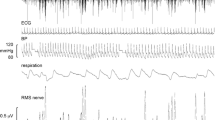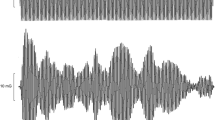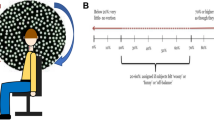Abstract
Motion sickness is associated with a variety of autonomic symptoms, presumably due to proximity or functional interconnectivity between the autonomic centers in the brainstem and the vestibular system. A direct influence of the vestibular system on cardiovascular variables, defined as the vestibulo-sympathetic reflex, has been reported previously. Our aim was to investigate the sudomotor components of the autonomic responses associated with motion sickness during passive cross-coupling stimulation (“roll while rotating”). Healthy subjects (n = 17) were rotated at 40°/s around an earth-vertical yaw axis alone and in combination with sinusoidal roll oscillations (0.2 Hz). Motion sickness was assessed verbally every minute using a 1–10 scale, while recording DC and AC skin conductance levels (SCL) from the forehead. Yaw rotation alone provoked neither motion sickness nor variations of forehead sweating. Yet during cross-coupling stimulation all subjects reported motion sickness. Higher motion sickness scores (>5) were associated with significantly higher amplitudes of AC-SCL events compared to the lower scores (0.22 ± 0.01 vs. 0.11 ± 0.01 µS, respectively). Frequency domain analysis of the AC-SCL events revealed a peak at 0.2 Hz, coinciding with the frequency of the chair rolls. The total power of AC-SCL signals did not match the trend of motion sickness scores across conditions. We conclude that: (1) although SCL is related to motion sickness, it does not follow the perceived sickness closely; (2) the discrepancy between SCL and motion sickness and the rhythmic AC-SCL events could reflect a sudomotor component of the vestibulo-sympathetic reflex.



Similar content being viewed by others
References
Lackner JR, Graybiel A (1986) The effective intensity of Coriolis, cross-coupling stimulation is gravitoinertial force dependent: implications for space motion sickness. Aviat Sp Environ Med 57:229–235
Bertolini G, Straumann D (2016) Moving in a moving world: a review on vestibular motion sickness. Front Neurol 7:14. doi:10.3389/fneur.2016.00014
Reason JT, Brand JJ (1975) Motion sickness. Academic Press, New York
Reason JT (1978) Motion sickness adaptation: a neural mismatch model. J R Soc Med 71:819–829. doi:10.1177/014107687807101109
Murdin L, Chamberlain F, Cheema S et al (2015) Motion sickness in migraine and vestibular disorders. J Neurol Neurosurg Psychiatry 86:585–587. doi:10.1136/jnnp-2014-308331
Paillard AC, Quarck G, Paolino F et al (2013) Motion sickness susceptibility in healthy subjects and vestibular patients: effects of gender, age and trait-anxiety. J Vestib Res Equilib Orientat 23:203–210. doi:10.3233/VES-130501
Golding JF (2006) Motion sickness susceptibility. Auton Neurosci Basic Clin 129:67–76. doi:10.1016/j.autneu.2006.07.019
Nalivaiko E, Rudd JA, So RH (2014) Motion sickness, nausea and thermoregulation: the “toxic” hypothesis. Temperature 1:164–171. doi:10.4161/23328940.2014.982047
Hemingway A (1944) Cold sweating in motion sickness. Am J Physiol 141.2:172–175
McClure AJ, Fregly AR, Molina E, Graybiel A (1972) Response from arousal and thermal sweat areas during motion sickness. Aerosp Med 43:176–179
Golding JF (1992) Phasic skin conductance activity and motion sickness. Aviat Sp Environ Med 63:165–171
Wan H, Hu S, Wang J (2003) Correlation of phasic and tonic skin-conductance responses with severity of motion sickness induced by viewing an optokinetic rotating drum. Percept Mot Skills 97:1051–1057. doi:10.2466/pms.2003.97.3f.1051
Golding JF, Stott JR (1997) Comparison of the effects of a selective muscarinic receptor antagonist and hyoscine (scopolamine) on motion sickness, skin conductance and heart rate. Br J Clin Pharmacol 43:633–637. doi:10.1046/j.1365-2125.1997.00606.x
Cowings PS, Suter S, Toscano WB et al (1986) General autonomic components of motion sickness. Psychophysiology 23:542–551. doi:10.1111/j.1469-8986.1986.tb00671.x
Yates BJ, Bolton PS, Macefield VG (2014) Vestibulo-sympathetic responses. Compr Physiol 4:851–887. doi:10.1002/cphy.c130041
Carter JR, Ray CA (2008) Sympathetic responses to vestibular activation in humans. Am J Physiol Regul Integr Comp Physiol 294:R681–R688. doi:10.1152/ajpregu.00896.2007
Garrick-Bethell I, Jarchow T, Hecht H, Young LR (2008) Vestibular adaptation to centrifugation does not transfer across planes of head rotation. J Vestib Res 18:25–37
Gavgani AM, Nesbitt KV, Blackmore KL, Nalivaiko E (2016) Profiling subjective symptoms and autonomic changes associated with cybersickness. Auton Neurosci. doi:10.1016/j.autneu.2016.12.004
Ramat S, Bertolini G (2009) Estimating the Time Constants of the rVOR. Ann NY Acad Sci 1164:140–146. doi:10.1111/j.1749-6632.2009.03855.x
Bertolini G, Ramat S (2011) Velocity storage in the human vertical rotational vestibulo-ocular reflex. Exp Brain Res 209:51–63. doi:10.1007/s00221-010-2518-6
Acknowledgements
The research was supported by the Swiss National Science Foundation and the Dr. Dabbous Foundation.
Author information
Authors and Affiliations
Corresponding author
Ethics declarations
Conflicts of interest
The authors declare no conflict of interest.
Additional information
This manuscript is part of a supplement sponsored by the German Federal Ministry of Education and Research within the funding initiative for integrated research and treatment centers.
Rights and permissions
About this article
Cite this article
Romano, F., Caramia, N., Straumann, D. et al. Cross-coupling vestibular stimulation: motion sickness and the vestibulo-sympathetic reflex. J Neurol 264 (Suppl 1), 96–103 (2017). https://doi.org/10.1007/s00415-017-8496-x
Received:
Revised:
Accepted:
Published:
Issue Date:
DOI: https://doi.org/10.1007/s00415-017-8496-x




